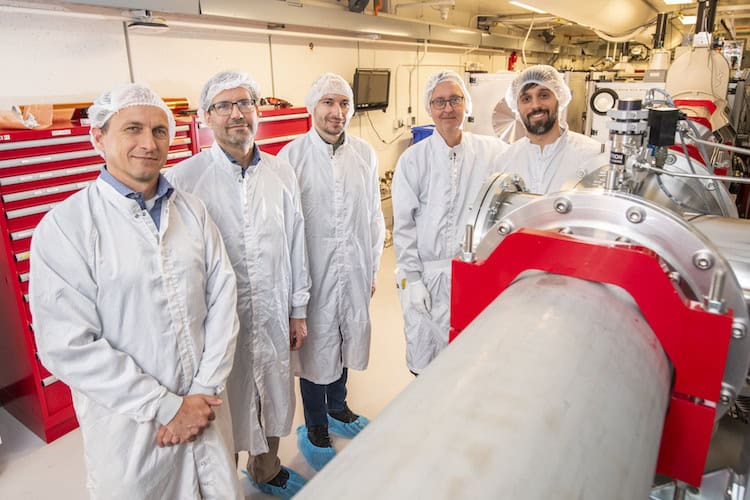Science
Researchers Develop Compact Source for High-Energy Muon Beams

Physicists at the **Lawrence Berkeley National Laboratory (LBNL)** have made significant progress in the generation of high-energy muon beams using laser plasma acceleration (LPA). Their research, which remains unconfirmed by government officials due to the ongoing U.S. government shutdown, could pave the way for ultracompact muon sources. These sources hold promise for various applications, including muon tomography, a technique that enables imaging of large objects where traditional X-ray methods are impractical.
Muons are subatomic particles similar to electrons but approximately **200 times heavier**, allowing them to penetrate materials more effectively. This unique property makes them useful for imaging thick structures, including nuclear reactors and ancient monuments like the Great Pyramid of Giza. Currently, cosmic rays produce about **10,000 muons** per square meter of the Earth’s surface each minute, but their unpredictable nature and vertical directionality limit their utility for detailed imaging.
To overcome these challenges, Terzani and his team have developed a new compact muon source based on LPA-generated electron beams. This innovative approach could enable muon production in specific directions and in smaller facilities, making it more accessible for various applications.
Advances in Laser Plasma Acceleration
The LPA technique utilizes an ultra-intense, ultra-short laser pulse directed into an “under-dense” gas. This laser pulse ionizes gas atoms, generating a plasma and creating accelerating fields that exceed those of traditional radio-frequency cavities. In their recent experiment, the researchers achieved a **10 GeV** electron beam from a **30 cm** gas target for the first time. Upon colliding this electron beam with a dense target like tungsten, they produced a short-lived burst of muons that travels along the same axis as the incoming beam.
The team succeeded in filtering out background radiation to isolate the muon signal, identifying two distinct populations of muons. One population was collimated and forward-directed, generated through pair production, while the other was isotropic and lower-energy, resulting from meson decay.
Applications and Future Potential
Although the new LPA technique does not yet yield muon fluxes suitable for large-scale particle physics experiments, its potential applications are vast. Muons can be utilized to inspect the interiors of structures such as blast furnaces and nuclear waste facilities. The recent discovery of a hidden chamber in **Khufu’s Pyramid** underscores the effectiveness of muon tomography in archaeology and geology.
The findings from this study are detailed in the journal **Physical Review Accelerators and Beams**, where the researchers expressed optimism about the future of LPA-generated muons. While their original funding has ended, they are committed to continuing their work, aiming to measure the muon beam’s flux and spectrum using advanced detection techniques, including ultra-fast particle trackers.
Furthermore, the researchers are exploring avenues to enhance the energy of their muon source, which poses significant challenges for penetrating soil in applications such as imaging deep ore deposits. Their ongoing investigations could bridge the gap between muon technology and future collider developments, offering a pathway toward innovative advancements in particle physics.
The team’s efforts to harness the potential of LPA-generated muons illustrate the transformative possibilities inherent in this cutting-edge technology, laying the groundwork for future breakthroughs in both scientific research and practical applications.
-

 Health2 months ago
Health2 months agoNeurologist Warns Excessive Use of Supplements Can Harm Brain
-

 Health2 months ago
Health2 months agoFiona Phillips’ Husband Shares Heartfelt Update on Her Alzheimer’s Journey
-

 Science2 weeks ago
Science2 weeks agoBrian Cox Addresses Claims of Alien Probe in 3I/ATLAS Discovery
-

 Science2 weeks ago
Science2 weeks agoNASA Investigates Unusual Comet 3I/ATLAS; New Findings Emerge
-

 Science1 week ago
Science1 week agoScientists Examine 3I/ATLAS: Alien Artifact or Cosmic Oddity?
-

 Entertainment4 months ago
Entertainment4 months agoKerry Katona Discusses Future Baby Plans and Brian McFadden’s Wedding
-

 Science1 week ago
Science1 week agoNASA Investigates Speedy Object 3I/ATLAS, Sparking Speculation
-

 World2 months ago
World2 months agoCole Palmer’s Cryptic Message to Kobbie Mainoo Following Loan Talks
-

 Entertainment3 months ago
Entertainment3 months agoEmmerdale Faces Tension as Dylan and April’s Lives Hang in the Balance
-

 Science1 week ago
Science1 week agoNASA Scientists Explore Origins of 3I/ATLAS, a Fast-Moving Visitor
-

 Entertainment4 months ago
Entertainment4 months agoLove Island Star Toni Laite’s Mother Expresses Disappointment Over Coupling Decision
-

 Entertainment2 months ago
Entertainment2 months agoMajor Cast Changes at Coronation Street: Exits and Returns in 2025









